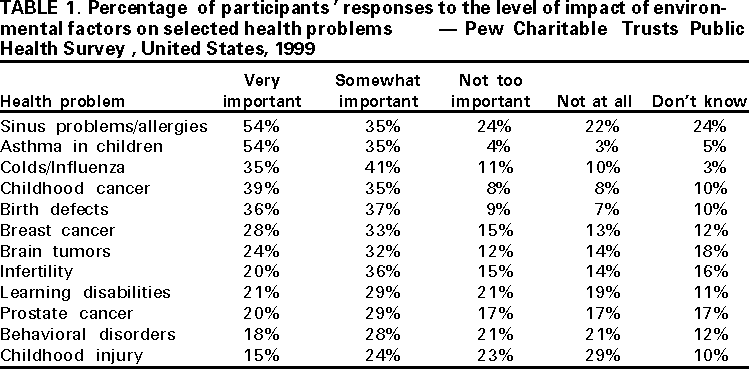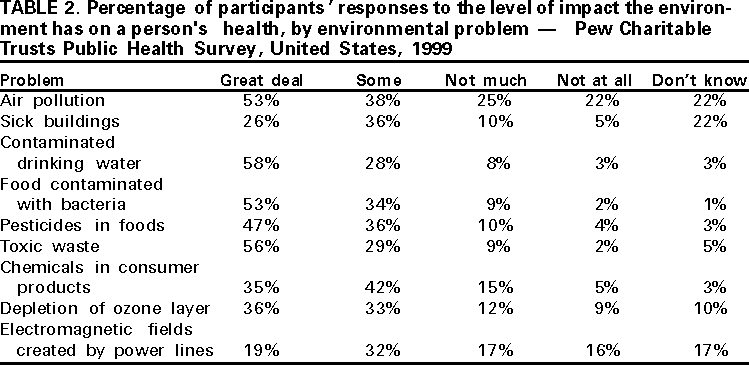 |
|
|
|
|
|
|
| ||||||||||
|
|
|
|
|
|
|
||||
| ||||||||||
|
|
|
|
|
Persons using assistive technology might not be able to fully access information in this file. For assistance, please send e-mail to: mmwrq@cdc.gov. Type 508 Accommodation and the title of the report in the subject line of e-mail. Public Opinion About Public Health --- United States, 1999Please note: An erratum has been published for this article. To view the erratum, please click here. Previous surveys have documented a substantial gap in the public's understanding and attitudes about public health (1). The Pew Charitable Trusts, a Philadelphia-based philanthropy that supports nonprofit activities in the areas of culture, education, the environment, health and human services, public policy, and religion, commissioned two firms, the Mellman Group and Public Opinion Strategies, to conduct both qualitative and quantitative research in 1999 to characterize the public's attitudes about public health. In particular, the Pew Charitable Trusts asked the groups to explore 1) perceptions about public health in general, including levels of support and importance compared with other national priorities; 2) opinions about environmental health and its role in causing disease and promoting health; and 3) opinions about the public health infrastructure. This report summarizes the results of this survey, which indicate that the term "public health" is misunderstood, persons are concerned about the quality of the public health system, increased government spending for public health is a greater priority than other key national concerns, and that the public regard environmental factors as important contributors to certain health problems. During March 24--31, 1999, the groups conducted a national telephone survey of 1234 registered voters. Registered voters, selected by random-digit--dialing, were chosen because of their potential influence on setting government priorities. Respondents were first asked to respond to a series of statements defining public health. Respondents were then given a definition of public health (i.e., protecting the population from disease) and asked a series of questions about federal resources devoted to public health and other programs. Respondents also were asked about their beliefs on the links between environmental factors and disease. The sampling margin of error was +2.8% at the 95% confidence level. Respondents were asked "When you hear the term `public health,' what do you think of?" and then given a choice of four descriptions. Approximately half (57%) of the respondents could not define public health as either protecting the population from disease or policies and programs that promote healthy living conditions for everyone. Interviewers then defined public health and asked respondents to rate (i.e., excellent, good, fair, or poor) the current system for protecting public health. Most (57%) respondents offered negative evaluations of the public health system. Respondents also were asked whether sufficient resources were being dedicated to public health; 65% said that the United States should do more to protect public health. When asked to compare public health as a spending priority with several other key programs, most said public health was more deserving of additional funds than building roads and highways (80%), missile defense (73%), and cutting taxes (63%). Only education was viewed as a greater priority for additional resources (24%). When asked about environmental factors (e.g., pollution) and their relation to public health, 85% said they believed that environmental factors are important determinants of disease and health problems. Of these, 38% considered environmental factors very important. Respondents were asked to indicate how much impact environmental problems have on the public health. Most respondents believed that environmental factors play an important role in causing certain diseases. Sinus and allergy problems (54%), childhood asthma (54%), childhood cancer (39%), colds and influenza (35%), and birth defects (36%) were the health problems seen as most likely resulting from environmental factors (Table 1). Respondents were given nine environmental issues and asked what impact each had on the population's health (a great deal, some, not too much, not at all, or don't know). Contaminated drinking water (58%), toxic waste (56%), air pollution (53%), foods contaminated with bacteria (53%), and pesticides in foods (47%) were considered to have the greatest impact (Table 2). Reported by: SA Hearne, DrPH, PA Locke, DrPH, Pew Environmental Health Commission, Johns Hopkins School of Public Health, Baltimore, Maryland. M Mellman, P Loeb, L Dropkin, Mellman Group; G Bolger, N Fink, Public Opinion Strategies, Washington, DC. M Byrnes, MPA, Pew Charitable Trusts, Philadelphia, Pennsylvania. Editorial Note:Societal support is critical for public health efforts, which target population-based disease prevention and collective action. Since 1981, financial support for public health infrastructure has decreased (2,3), and national expenditures for health-care services have increased (4,5). The diminishing resources for public health combined with the increasing costs of medical intervention may indicate a failure to communicate the efficacy of public health practices and programs. The findings in this report are subject to at least two limitations. First, the survey design defined public health but not the public health system. Second, spending priorities do not necessarily address support of specific public health initiatives. The survey does indicate substantial support for public health when the public understands the concept, which has important implications for how public health professionals communicate with the public, policymakers, and the media. The findings in the survey indicate that most registered voters believe the environment is an important determinant in maintaining good health. The identification of environmental health issues with public health may enable public health professionals to better inform the public about the importance of a population-based focus on disease prevention. References
Table 1  Return to top. Table 2  Return to top. Disclaimer All MMWR HTML versions of articles are electronic conversions from ASCII text into HTML. This conversion may have resulted in character translation or format errors in the HTML version. Users should not rely on this HTML document, but are referred to the electronic PDF version and/or the original MMWR paper copy for the official text, figures, and tables. An original paper copy of this issue can be obtained from the Superintendent of Documents, U.S. Government Printing Office (GPO), Washington, DC 20402-9371; telephone: (202) 512-1800. Contact GPO for current prices. **Questions or messages regarding errors in formatting should be addressed to mmwrq@cdc.gov.Page converted: 3/30/2000 |
|||||||||
This page last reviewed 5/2/01
|